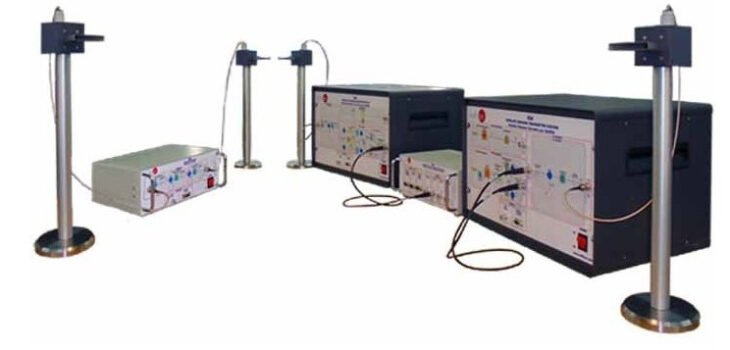 Applied Communications
Applied Communications
General Descriptions
The “ESA” trainer is an advanced system that operates in conjunction with a computer (PC), which allows students an easy way to manage and visualize the data. The “ESA” software allows to perform multiple actions: configuring the sending data, selecting the desired test point to visualize, selecting different faults in the equipment, etc.
The “ESA” trainer is divided into different modules to allow the student a better understanding of the unit. These modules are: Satellite Ground Transmitter Station, Satellite Ground Receiver Station, Satellite Repeater and the Control Signal and Data Acquisition Module.
The Satellite Ground Transmitter Station works as a real ground based equipment, transmitting the signal (Uplink) to the Satellite Repeater through the Satellite Ground Transmitter Antenna. The Satellite Ground Receiver Station works as a real ground based equipment, receiving the signal (Downlink) from the Satellite Repeater through the Satellite Ground Receiver Antenna. Both, Transmitter and Receiver, are connected to the computer for signal analysis, configuring the data transmission, data visualization, etc.
The Satellite Repeater Module works as real active satellite repeater. It includes a processing system that amplifies the incoming signal from the Satellite Ground Transmitter Station (Uplink) through the Satellite Receiver Antenna, and emits the processed signal in a different band of frequencies (Downlink) through the Satellite Transmitter Antenna.
GUIDED PRACTICAL EXERCISES INCLUDED IN THE MANUAL
- Study of the operation principles of a satellite communication system.
- Basic principles of analog modulation, frequency modulation (FM).
- Basic principles of analog demodulation, frequency modulation (FM).
- Basic principles of digital modulation, differential quadrature phase shift keying (DQPSK).
- Basic principles of digital demodulation, differential quadrature phase shift keying (DQPSK).
- Study of the characteristics of the Satellite Ground Transmitter Station, Satellite Repeater and Satellite Ground Receiver Station.
- Study of the communication system through a Satellite Repeater performing the uplink and downlink.
- Performing data transfers through a satellite communication system (Satellite Ground Transmitter Station–Satellite Repeater- Satellite Ground Receiver Station).
- Study of the quality of the data transmission link.
- Analysis of the system response with different fault insertions in the Satellite Ground Transmitter Station.
- Analysis of the system response with different fault insertions in the Satellite Repeater.
- Analysis of the system response with different fault insertions in the Satellite Ground Receiver Station.
